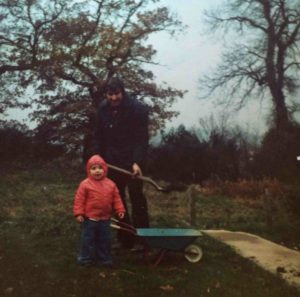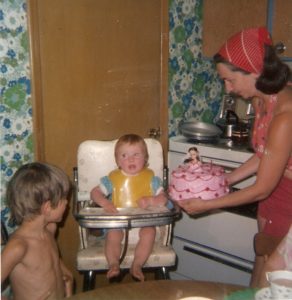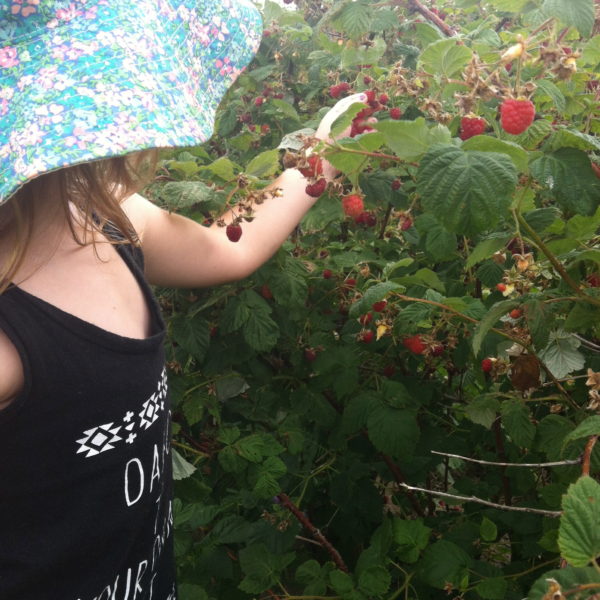With over a decade of post high school nutrition education under my belt, I have more than a passing understanding of the complex relationship between the food we consume and our health; I may even be considered an expert in the field. However, I have come to understand that when it comes to eating well, there are some things that cannot be gained from studying a book.
As a mother who is keen for my two children to develop a positive relationship with food, lately I have spent some time reflecting on the values that my own mother instilled in me. What I once thought were old-fashioned, frugal, and even quirky traits, I now (3 decades later) see as progressive, healthy and wise. Growing up, the following 8 principals were a fundamental part of our daily routine.
- Always Plan Ahead
There was always a list (or two) on the kitchen counter. One described the ‘menu’ for the week ahead, annotated to indicate the items that needed to be prepped and when. The second was a shopping list based on the content of the weekly menu. Mum went grocery shopping on a Tuesday, occasionally picking up a few additional items at the corner store later in the week. She baked and cooked in large batches that she would freeze in smaller portions. She’d wash and peel carrot sticks and place them in tupperware ready for a grab and go snack.
There was a specific order to the weeknight dinners: traditional roast on a Sunday, ‘leftovers’ on a Monday, sausages or pork chops on a Tuesday, a casserole on a Wednesday, a ground beef dish on a Thursday, fish and chips on a Friday, and burgers on a Saturday. The specific recipe and accompaniments changed weekly, providing a perfect balance between routine and variety. With a busy household of six individuals not only did this planning make sure there was always a balanced meal or snack on hand, it also helped to contain food spending.
- Buy Local
Back then, locavores were not ‘a thing’, we simply lived in a small rural market town and sourced our food from local suppliers. The ‘milk man’, who happened to be the local dairy farmer, delivered our milk to our doorstep every morning. We’d pick up sacks of potatoes from the potato farm, and trays of eggs from the egg farm. Once a week, the ‘fishmonger’ and ‘fruit and veg man’ would drive their small vans into the cul-de-sac and mum would buy what she needed. Anything else was purchased at the weekly market in the town square or at the supermarket. There is even the story where she was directed to the animal feed store to buy bran for baking!
- Get Your Hands Dirty

Despite the rocky and poor soil in our backyard, my mum kept a small garden. Among other things she grew herbs, peas, beans, strawberries, rhubarb, and gooseberries. Nothing beat growing our own produce, picking it, and consuming it fresh. Gardening is also a fun, kid-friendly activity and a great way to learn about how food is grown. Although I must admit I think I was much more helpful at the harvesting part than the weeding!
- Home Cooked Meals
It was only when I started to attend play dates at friends houses that I discovered the existence of frozen french fries and fish fingers. Although I was familiar with this meal, in our house it involved my mum peeling potatoes and chopping them into long sticks; dipping pieces of fresh fish in milk, then a flour and breadcrumb mixture before placing them all in a pan of hot oil. It did not involve opening a packet and placing it on a tray in the oven.
My mum, ever humble, claims that she is not a ‘fancy’ cook, but she did spend a lot of time in the kitchen preparing food from fresh ingredients. For several hours each Saturday she would bake for the week ahead: cookies, muffins, fruit loaf, and pies. She would keep going until every inch of counter space was covered in flour.
- A Family That Eats Together Stays Together
Only on Saturday evenings were we allowed to eat in front of the TV, every other day we sat together at the dining room table. Dinner would start with grace, a brief moment to pause as a family and say thanks. This gesture involved holding hands until my brother squeezed my fingers to the point of breaking them and from then on our hands stayed firmly in our laps! Our dinnertime conversation covered everything from what had happened at school that day, plans for the weekend, local and national news, to who left the toilet seat up! It was loud and disjointed and not highly intellectual but it was still precious family time. In recent years studies have shown that children and teenagers who eat more meals with their parents have higher academic performance and are less likely to partake in destructive behaviours such as smoking, drinking alcohol, and illegal drug use.
- Slow Down and Chew Your food
If you look in the Guiness Book of World Records under ‘Worlds slowest eater’ you may just find my mums name! Her slow eating was a wondrous feat considering the chaos that surrounded her at dinnertime. Typically, Dad would be hurrying to finish so he could get to a meeting, I’d be wandering in late from Girl Guides. Everyone had something to do or some place to go, but mum would sit there and savour every bite, pausing and placing her cutlery down between each mouthful. Of course we now know that eating slowly is associated with increased satiety, a reduction in overall caloric intake, and less risk of obesity. My mum is proof of this.
- Leave Room for Dessert

Our evening meal always included dessert. If my mum had not baked something she would offer us ice cream, yogurt or fruit. But the key here was moderation. The portion size were just a fraction of what you would be served in a restaurant and we felt satisfied with that. We were all active kids and for the most part our diet was low in processed foods, added sugars, and moderate in fat. I still always leave room for dessert, especially if it is one of mums pies!
- Reduce Food Waste
My mum was an expert at using every morsel of food in the kitchen. Any ‘left-overs’ were incorporated into a new dish the next day, surplus food like bread or berries were frozen in usable portions, even the dust at the bottom of the cereal boxes was mixed into a batch of muffins. This conservation extended beyond food; the veggie peels were discarded in a compost pit in the backyard, glass jars and plastic cartons were kept as storage containers, and paper boxes were put away for rainy day craft projects.
I recently asked my mother, what, in an era when highly processed foods were de rigueur, was her motivation for preparing home cooked meals with whole fresh local ingredients? Her answer was unexpected. She told me that as a housewife, the management of our home (and raising us) was the focus of her career, so she was determined to excel at it. She couldn’t justify taking shortcuts like buying pre-packaged processed foods, as in her words “that would be cheating” (so I guess the pressure to be a ‘super mum’ is not a social media phenomenon after all)! Linked to the fact that she did not work outside the home, was the practical consideration that we were living on a single income, so what she was unable to bring in financially through external employment she sought to save through the steps I’ve described. Unbeknown to her, she was providing us with a positive example of how to eat in a healthy and sustainable way.
Turns out that my mum was ahead of the curve. In the last few years, governments and non-profits have convened panels of experts to revise dietary guidelines and develop new policies with the goal of reducing the populations intake of high sugar, high fat processed foods and ensure the sustainability of our food system. Many of the subsequent recommendations have mirrored what I have described here… Perhaps they should have just spoken to my mum!
P.S. I asked mum for some photos to illustrate this post, her reply was “I haven’t been very successful at finding any pictures …. I guess I was too busy to take them!”






Leave a Reply